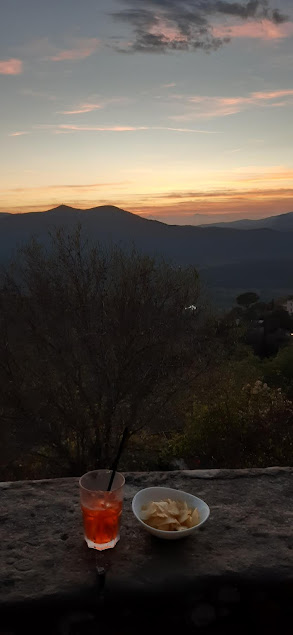https://www.discovertuscany.com/maremma/
http://www.travelingintuscany.com/engels/maremma.htm
At the beaches in Italy, it is common to pay for services at a "bagno". Each bagno has a name and provides what you need for the day-- lounge chairs and umbrella, a place to change, bathrooms, and a restaurant. The colors of the umbrellas vary from one bagno to another, which creates the rainbow that you see in the pictures of Italian beach resorts. Since it was already the first of October, only a few of the bagnos were open. We had a very nice spot with Bagno La Vela which we enjoyed for two days of sun and waves.
http://www.castiglionepescaia.it/en/5079-2/
On our first evening, we drove to Vetulonia for an aperitivo and sunset. The origins of the town date back to Etruscan times- approximately 600 years BC. In past years, my friends rented a flat in Vetulonia to use a base to go to the beach and explore the area. I had also been to Vetulonia with them before and understood its lure. When we arrived to one of the few bars, they were greeted warmly. The bar with a view to the sunset is a popular gathering spot. I asked my friend about the population and she reminded me that there are 254 inhabitants. There was a mix of old and young having a spritz or beer. I wondered what it would be like to live in such a small community, full of natural beauty and history, though none of the activities that I enjoy.
Dinner both evenings were at a local restaurant near our B and B. The restaurant was busy, with tables inside and outside. There were German tourists at the table next to us. The service was efficient, the wine and food very good. The first night I had cream of pumpkin soup, salad, tagliatelle with cinghiale (wild boar sauce). The second night I had pizza. Certo! Speaking of wild boars, we did spot a white boar on the side of the road as we drove back in the dark to where we were staying. The next night, I was awakened by clacking and digging sounds-- wild boar tearing up the yard to eat the roots of the grass. I did not get out of bed to investigate, and in the morning was a bit regretful that I had missed such a photo opportunity.
The time at the beach, early morning swims, and good company were just the reset I needed after a frustrating week of trying to recover the items that were in my stolen wallet.
The third day we bypassed the beach and instead went to a small farm and then the old city of Massa Marittima. That will be a separate post.


















